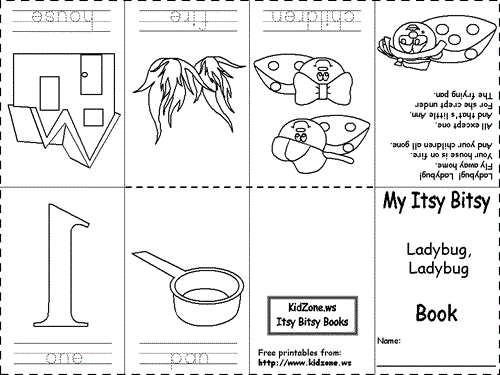DLTK's Nursery Rhymes for Kids
Ladybug, Ladybug Fly Away Home Nursery Rhyme
Ladybug! Ladybug!
Fly away home.
Your house is on fire.
And your children all gone.
All except one,
And that's little Ann,
For she crept under
The frying pan.
Ladybug, Ladybug Fly Away Home Lyrics and Coloring Pages:
Ladybug, Ladybug Fly Away Home Crafts:

My House Paper Craft
For other Home and Family crafts (various ages) check the "My Family" section.

My House Milk Carton Craft
For other Home and Family crafts (various ages) check the "My Family" section.
Ladybug, Ladybug Fly Away Home Printable Resources:
Ladybug, Ladybug Fly Away Home Puzzle Worksheets:
The History of "Ladybug, Ladybug Fly Away Home"
"Ladybug, Ladybug Fly Away Home" is a traditional English nursery rhyme that has been recited by children for generations. The rhyme features a plea to a ladybug, encouraging it to return home to its children. Its origins are believed to be deeply rooted in European folklore and agricultural traditions.
Origins and Early History
The exact origins of the rhyme are not well-documented, but it is thought to date back to medieval times. The earliest recorded version of "Ladybug, Ladybug Fly Away Home" appeared in "Tommy Thumb's Pretty Song Book." This collection, published in 1744, is one of the oldest known books of English nursery rhymes. "Tommy Thumb's Pretty Song Book" is significant in the history of children's literature, as it was among the first attempts to gather popular nursery rhymes into a printed collection.
The rhyme's connection to ladybugs, also known as ladybirds in the UK, is linked to their role in agriculture. Ladybugs are beneficial insects that help control pest populations, particularly aphids, which threaten crops. Farmers and gardeners would recite the rhyme as a way of encouraging ladybugs to stay and protect their plants.
The earliest printed version of the rhyme appeared in the late 18th or early 19th century, but it likely existed in oral tradition long before that. The rhyme was included in the collection "Mother Goose's Melody" and has been passed down through generations.
Cultural Significance and Interpretations
The rhyme carries themes of protection and care, as it mentions the ladybug's home and children. Historically, the rhyme has been associated with the belief that ladybugs bring good luck and protection. In some versions, the rhyme includes references to dangers such as fires, reflecting the agricultural practices of burning fields after harvest to clear stubble and pests.
Visual and Musical Adaptations
"Ladybug, Ladybug Fly Away Home" has been featured in numerous children's books, often accompanied by colorful illustrations that depict the ladybug's journey. These visual interpretations add a layer of charm and appeal, making the rhyme a favorite among young children. The rhyme has also been set to music and included in nursery rhyme collections, further enhancing its accessibility and enjoyment.
Educational Uses
The rhyme is commonly used in early childhood education to teach rhythm, memorization, and language skills. It also serves as an introduction to the natural world, helping children learn about insects and their importance in the ecosystem. The simple and repetitive structure of the rhyme makes it an effective tool for developing early literacy skills.
Enduring Popularity
The enduring popularity of "Ladybug, Ladybug Fly Away Home" can be attributed to its simplicity, charm, and connection to nature. It continues to be a favorite in homes, schools, and cultural celebrations of traditional nursery rhymes, providing comfort and joy to young listeners.









